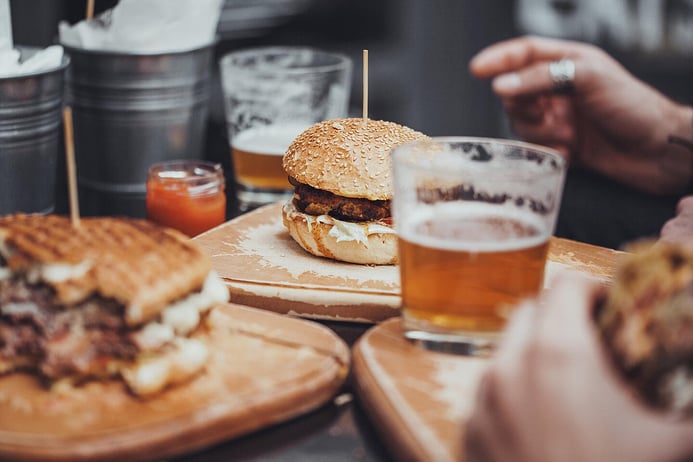Fast food has never been short on bold ideas, but the latest twist is catching even seasoned operators off guard. Burgers with beer. Tacos with hard seltzer. Coffee chains flirting with wine nights.
It started as a few cautious experiments and slowly turned into one of the industry’s most interesting menu shifts. Some brands are chasing higher margins, others are trying to win back the evening crowd, and a few are simply testing how far their customers’ expectations can stretch.
The real question is whether alcohol can genuinely reshape the fast-food playbook or if it’s destined to remain a clever, limited-run experiment. In this guide, we’ll discuss the answer to that question as well as how the trend began and why it didn’t quite take-off globally.
How the Trend Started

The push to introduce booze in fast-food settings didn’t happen overnight. It emerged from a mix of shifting consumer habits and mounting competitive pressure.
Throughout the late 2000s and early 2010s, fast-casual brands began redefining what “quick service” could look like by offering higher-quality ingredients, more comfortable dining rooms, and in many cases, wine or beer as part of the experience.
This appealed to younger, urban consumers who were looking for convenience without giving up the social elements traditionally associated with sit-down restaurants. As fast-casual chains grew, they started capturing occasions that used to belong to fast food, especially relaxed evening meals and group outings.
Fast-food executives noticed that these new competitors weren’t just winning customers on food quality. They were attracting a demographic with greater spending power and a willingness to treat dining out as a social activity. Alcohol naturally fit into that pattern.
Offering beer or simple mixed drinks became an attractive way for fast-food brands to signal a more modern identity and tap into the same evening and weekend occasions that fast-casual players were capturing.
This also aligned with a broader shift in consumer behaviour, where booze had become more normalized in casual, quick-service environments such as food halls, cinemas, and even some grocery stores.
Why the Trend Hasn’t Gone Global (Yet)

The higher prices of alcoholic menu items helps increase the customers’ average check and restaurants serving it are more likely to attract customers at night which counterbalances typical sales patterns, often heavily reliant on breakfast and lunch business.
Already in 2013, Chipotle started serving Margaritas in some of its locations. Taco Bell took a different approach by choosing to add boozy drinks to the menu of their newly created upscale Cantina restaurants. The unspoken rule of not serving boozy drinks was also broken by Burger King at some of their Whopper Bars, as well as Starbucks with their evening concept in 2010, serving beer and wine at select locations.
If serving booze at fast food restaurants has proved trendy, most efforts have remained modest with no global roll-out in sight. And there are many reasons for this.
Licensing Costs and Logistical Hurdles
In the U.S for instance, liquor licenses in the U.S are not only expensive and complicated to obtain, but also carry hefty annual renewal fees in many states. Additionally, offering alcoholic beverages comes with large logistical efforts and to make matters worse, many states have geographical restrictions on the sale of these beverages.
Regulations often make it harder to find real estate, as there might be limitations on the allowed distance to churches and schools if an establishment wishes to serve alcohol. This is why for many fast-food chains, alcohol is frequently relegated to "special" locations, seemingly designed around the novelty of serving it.
Potential Problems and Customer Perception
Public authorities have also been warning that the addition of booze to thousands of fast-food locations could be a source of new problems such as drunk driving, violence, and alcoholism. Case in point, Burger King were turned down in 2016 when applying for a license to sell beers at their branches in Victoria and Paddington in the U. K after police raised safety concerns.
Fast-food executives argue that their typical customer usually sees the consumption of their products as a social occasion with a group of friends. To limit the negative effects, fast-food chains are taking measures to ensure a responsible serving policy to retain a family-friendly environment (such as clearly marked glasses or not serving alcohol at drive-thrus) and capitalize on an overall positive perception from their customers.
Does Booze Actually Improve the Business Case?

While it can lift average check sizes, the broader financial picture is far more nuanced. For many fast-food chains, the economics of alcohol service do not meaningfully shift unit performance once all associated costs are factored in.
Mixed drinks and beer come with attractive margins on paper, but the gains are often offset by higher labor spend, longer service times, and stricter oversight requirements. It also demands more controlled processes than typical fast-food workflows, which are built around speed and standardization rather than discretionary checks and service delays.
Location-specific performance adds another constraint. Alcohol tends to perform well only in a narrow set of environments, usually dense urban neighborhoods, transport hubs, and nightlife-adjacent areas where customers view fast food as a social or pre-drink stop.
In suburban or commuter-heavy markets, where families and solo diners dominate, the uplift is minimal. Chains are also discovering that booze does not significantly expand dayparts. Evening traffic rises in targeted zones, but breakfast and lunch, the core revenue drivers for many QSR brands, remain largely unaffected.
On top of this, alcohol service can complicate a brand’s operational model. Extra staff training, mandatory ID verification, more complex audits, and the risk of compliance violations introduce friction that quick-service restaurants typically seek to avoid.
These obligations may be manageable for fast-casual concepts with slower throughput, but they create tension in fast-food kitchens optimised for high volume and low variability. For franchise-heavy networks, uneven demand and inconsistent regulatory environments further reduce the potential for system-wide adoption.
Taken together, the business case for alcohol proves much narrower than initial enthusiasm suggests. It creates pockets of higher revenue rather than a transformative shift, which is why most brands continue to treat it as a selective enhancement rather than a universal upgrade.
What's Next?

The strategy seems to have shifted towards making alcohol available in highly targeted locations with a higher density of younger, urban consumers, with less regulatory hurdles to overcome or investing in new delivery channels altogether.
Case in point, although Starbuck's Evening concept was decommissioned in 2017, the coffee chain has not entirely stopped serving alcoholic beverages. Instead they will focus this area of their business on their new upscale retail and bar concept Starbucks Reserve.
So far, only four Reserve locations have opened in Milano, New York, Seattle and Shanghai but the company aspires to open more than a thousand sites worldwide.
Pizza Hut chose yet another way to enter the game by expanding their beer delivery services to almost 300 restaurants across seven U.S. states in January with a communicated plan to extend this service to up to 1000 locations by summer 2019.
Closing the Loop on Fast Food’s Boozy Experiment
Booze in fast food sits in that rare space between “clever idea” and “logistical headache”, which is exactly why it keeps popping up in pockets rather than sweeping the world. The appeal is obvious: higher margins, a fresh evening crowd, and a chance to feel a little more grown-up than the usual grab-and-go routine.
But the hurdles are just as clear, from licensing costs to operational slowdowns to the reality that not every neighborhood wants a beer with their burger. For now, this trend thrives where the conditions are right and fizzles where they’re not.
Whether it becomes a fixture or stays a novelty will depend on how well brands balance ambition with practicality, and how willing customers are to make alcohol part of their fast-food ritual.





